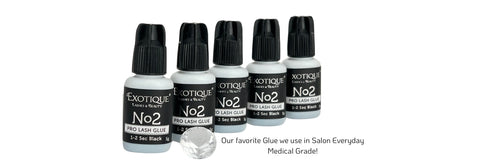
Patch Testing for Eyelash Extensions......Should we do this for every set?
Patch Testing is this necessary and when should we do it?
Years ago we were all told to patch test a little glue behind the ear, or on the inner of the elbow. As an industry we have grown so much since this was taught.
It is now a huge NO! to putting any glue on the skin. This really is asking for the client to have a reaction. Let's talk about how a patch test should be done for eyelash extensions and when.

How to perform a patch test
To do a patch test correctly you would book your client in, do a consultation, decide on the styling and the lashes you would use. You would then lay your client down and apply about 12 lashes per eye. The client would then go home and return the next day for you to assess if there is any inflammation or irritation. When they return if everything is all clear you would continue to complete the set.
If there is inflammation or irritation you definitely would not apply a full set. The client possibly needs to be referred for medical advice.
How does an allergic reaction occur?
An allergic reaction will occur when the client's immune system cannot tolerate a product during the treatment. Usually the glue is the culprit but it could be the lash pads, tape or any other product you may use. More often than not it is the glue, the cyanocryolate within the glue. This is one of the main ingredients in all lash glues. It is important to know that the glue you are using is classed as Medical Grade.
You can usually tell this by what the lash artist sells their sets for. A reputable Lash Artist will charge for the quality of their work and ingredients used. An allergic reaction usually looks like puffy swollen eyelids, often only one eye will be affected. This will be how a reaction starts. If you were to continue with future appointments the swelling would only become greater and greater endangering the eyes.
Can I use a Sensitive glue?
Using a sensitive glue doesn't really achieve anything only frustration! Firstly it's main base ingredient is cyanocryolate (which is probably what the client is allergic to) Yes it will have less vapours but it will take about 15seconds to dry and retention is usually only about 2 weeks. The client will more than likely still react.
Carbon Black can this be an issue?
Carbon Black is also a main ingredient of all black lash glues. This is what gives it it's colour. Yes this is an ingredient that could be the cause of a reaction. It is worth doing a patch test in the recommended way with a clear glue such as our Clarity Glue No7 to see if your client still reacts. Occasionally using this glue will avoid the issue as it has no Carbon Black in it.
A Client that has had a reaction years ago will they still react?
A client that has had a reaction years ago may still very well react. It is all about the immune system. The immune system does have a memory and approx. 95% of the time your client will react if future applications are done and is really not suitable to wear Eyelash Extensions.
When should a client have a patch Test.
I always recommend a patch test for clients who are Brides, attending a special function or travelling overseas. These are the last client's that most need to be worrying about a reaction occurring at the time of their special event. So please follow the patch testing advise above.

Can Glue touch the skin?
Glue should never touch the skin! So when we are applying a set of lashes always aim for your 0.5mm -1mm clearance at the base line. Also never put glue on the skin as a patch test as this is not best practice. The more skin is exposed to glue the more likely your client is to react. If you are a beginner, I always tell my students that they need to have their base further away from the lash line rather than too close to the lash line. Once your fine motor skills develop you will have more control and you will be able to consistently apply lashes 0.5 - 1mm from the base for beautiful sets of lashes.
Happy Lashing Everyone!




Leave a comment
This site is protected by hCaptcha and the hCaptcha Privacy Policy and Terms of Service apply.